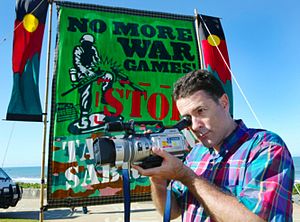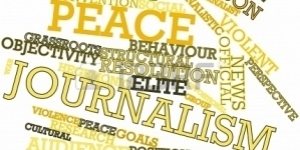Peace journalism
Peace journalism has been developed from research that indicates that often news about conflict has a value bias toward violence. It also includes practical methods for correcting this bias by producing journalism in both the mainstream and alternative media, and working with journalists, media professionals, audiences, and organizations in conflict.
This concept was proposed by Johan Galtung[1] Other terms for this broad definition of peace journalism include conflict solution journalism, conflict sensitive journalism,[2] constructive conflict coverage, and reporting the world.[3]
War journalism is journalism about conflict that has a value bias towards violence and violent groups. This usually leads audiences to overvalue violent responses to conflict and ignore non-violent alternatives. This is understood to be the result of well documented news reporting conventions. These conventions focus only on physical effects of conflict (for example ignoring psychological impacts) and elite positions (which may or may not represent the actual parties and their goals). It is also biased toward reporting only the differences between parties, (rather than similarities, previous agreements, and progress on common issues) the here and now (ignoring causes and outcomes), and zero sums (assuming that one side's needs can only be met by the other side's compromise or defeat).[4]
Peace journalism aims to correct for these biases. Its operational definition is "to allow opportunities for society at large to consider and value non-violent responses to conflict".[5] This involves picking up calls for, and articulations of, non-violence policies from whatever quarter, and allowing them into the public sphere.
Origins[edit]
Peace journalism follows a long history of news publication, originating in non-sectarian Christian peace movements and societies of the early 19th century, which published periodicals.[6] Sectarian organizations also created publications focused on peace as part of their proselytizing in the 19th century, as did utopian communities of the period. From the 20th century, a prominent example of sectarian journalism focused on peace was Dorothy Day's Catholic Worker.[7]
Besides being an element in the histories of pacifism and the social movement press, peace journalism is a set of journalism practices that emerged in the 1970s. Norwegian sociologist, peace researcher and practitioner Johan Galtung proposed the idea of peace journalism for journalists to follow to show how a value bias towards violence can be avoided when covering war and conflict.[8] Christian organizations such as The World Council of Churches and The World Association for Christian Communication also practice peace journalism.
Peace journalism aims to shed light on structural and cultural causes of violence, as they impact upon the lives of people in a conflict arena as part of the explanation for violence. It aims to frame conflicts as consisting of many parties and pursuing many goals rather than a simple dichotomy. An explicit aim of peace journalism is to promote peace initiatives from whatever quarter and to allow the reader to distinguish between stated positions and real goals.
Necessity[edit]
Peace journalism came about through research arguing there's something wrong with typical conflict reporting. Research and practice in peace journalism outlines a number of reasons for the existence and dominance of war journalism in conflict news.[9]
Other interests[edit]
Firstly, the notion that media elites always act to preserve their favored status quo, and their own commercial and political interests, is given relatively little weight. Shared characteristics of the socio-economic class, which heavily influences the production of journalism, are important. For example, their shared ideological pressures, perceptions, attitudes, and values form the basis of a "dominant reading" of facts that are selected to appear in news. These can then act to fix and naturalize meaning and hide the actual creation of meaning.[10]
However, even in the presence of powerful elite media interests against war, war journalism often dominates conflict discourse. Lynch and McGoldrick show examples from Britain, Ireland, Georgia, and Iraq, where war journalism dominated coverage despite key influential media interests against war.[11]
Journalistic objectivity[edit]
Therefore, not only political and economic, but also social and cultural factors have contributed to the dominance of war journalism in conflict reporting. With the growth of mass media, especially from the 19th century, news advertising became the most important source of media revenue.
Whole audiences needed to be engaged across communities and regions to maximize advertising revenue. This led to "Journalistic objectivity as an industry standard…a set of conventions allowing the news to be presented as all things to all people".[12] And in modern journalism, especially with the emergence of 24 hour news cycles, speed is of the essence in responding to breaking stories. It is not possible for reporters to decide "from first principals" every time how they will report each and every story that presents itself.[13] It follows that convention governs much of journalism.
The rise of journalistic objectivity was part of a larger movement within western academia to a more empirical "just report the facts” epistemology and research paradigm. By the 1890s it was focused on the ideal of “objectivity”.[14] And although it came into fashion around the same period, Journalistic Objectivity must be distinguished from the Scientific Objectivity. For example the experimental sciences uses as "best practice":
- Inter-laboratory replication;
- Random assignment of subjects to conditions;
- Efforts to ensure that human subjects and experimenters are ignorant of the expectations (hypotheses)of the research: to avoid the Observer-expectancy effect
- The Subject-expectancy effect;
- Anonymous peer review, a form of peer review, to promote open and systematic exploration of meaning without subjective, "political" bias;
- Careful analysis to ensure that research subjects are adequately representative of the general population, that is not overly atypical when compared to the average population.
While it is arguable whether these experimental science safe guards provide “true objectivity”, in the absence of these safeguards, journalism around conflict relies on three conventions to maintain its own form of "objectivity" ( also see journalistic objectivity), and is therefore distinct from Scientific Objectivity.
Conventions[edit]
Firstly, to sell audiences to advertisers, reporting must appeal to as broad an audience as possible and therefore focuses on “facts” that are the least controversial. Conflict processes are often controversial, so coverage of them risks alienating potential consumers, who may be sensitive to the exposure of structural or cultural predisposing factors.[15]
Secondly, a bias in favor of official sources means that, while it may appear uncontroversial, as there is only one official representative for the government on any given issue[16] and since only the official government is usually allowed to wield legal, sanctioned force within its territory[17] coverage will tend to privilege violent responses to conflict over non-violent, social-psychological, context-informed responses.[18]
Journalists Annabel McGoldrick and Jake Lynch argue that non-critical reporting of official sources is often rewarded by those sources. Through "information transactions", these same official sources allow uncritical journalists privileged access to information in the future.[19]
Thirdly and lastly, 'dualism' biasses journalistic objectivity towards violence: "A decision to tell a story in that [bipolar] way can slip past, unnoticed, without drawing attention to itself because of its close resemblance, in shape and structure, to so much of the story-telling we already take for granted".[20]
Gatekeeping[edit]
These conventions also form “gates” by which “gatekeepers” in journalism include or exclude various aspects of reality in final publication.[21]
In this way, proponents of peace journalism argue that in the media meaning occurs according to: “a set of rules and relations established before the reality or the experience under discussion actually occurred”.[22] In war journalism the objectivity conventions serve this purpose, but are shadowy and unacknowledged.[23] “Gatekeeping” is therefore likely to be secretive and haphazard. This means they distort, and also fix, meaning in conflict coverage and obfuscate the production of meaning[clarification needed].[24]
A recent example demonstrates how peace journalism evaluative criteria might be applied to show how much conventional conflict reporting is biased in favor of violence and violent groups. The example is the coverage leading up to the September 2009 meeting between Israeli Prime Minister Benjamin Netanyahu, Palestinian President Mahmoud Abbas, and US President Barack Obama.
Reporting was highly reactive and focused on the visible effects of the conflict, such as announcements and public disagreements between official spokespeople that appeared to disrupt peace efforts.[25]
Coverage was oriented to elites with little mention of non-official peace efforts by individuals and groups such as the Hand in Hand network of schools, the Israeli/Palestinian The Parents Circle Families Forum, Peace Now, Breaking the Silence, Physicians for Human Rights, Machsom Watch, and Checkpoint Watch, Hanan Ashrawi (non-violent activist for human rights, founder of the Palestinian Initiative for the Promotion of Global Dialogue and Democracy, and member of the Palestinian Legislative Council).[26][27]
Also ignored were programmes that promote cultural exchange, for example (the Israeli-Palestinian Aussie Rules football team The Peace Team), see here for official 2011 team details) which played in the 2008 and 2011 AFL International Cups. Another is the current programme of Palestinian children's visits to the Old Yishuv Court Museum in the Jewish Quarter of Jerusalem. Events demonstrating non-violent responses to the conflict were also ignored, a new example being the March 12, 2011, Conference on Civil Disobedience in the West Bank marking the centenary of International Women's Day.[28] Projects working for peace among Arabs and Israelis lists further organizations working for peace in the region, whose activities are generally excluded from news on the Conflict.
Reporting leading up to the September 2009 meeting between Netanyahu, Abbas and Obama focused almost solely on highly divisive issues, such as Israeli illegal settlements in the West Bank and Jerusalem, and the diplomatic/official status of Jerusalem. Coverage was also oriented towards differences, with a focus on the here and now. Potential benefits in physical, economic, and social security of peaceful relations were ignored, and “progress” towards peace was portrayed as having to come with one or more parties compromising and surrendering their positions on key issues, which is of course a zero sum orientation.[29] Coverage generally ignored the background or context of positions. Positions were presented as unchangeable on any peaceful settlement, rather than the public "face" of unmet needs that often drive violent conflicts. Because of distrust between parties these needs are often not honestly expressed publicly.[30]
Thus a pattern of war journalism emerges, largely stemming from the objectivity conventions applied to conflict reporting. Peace journalism argues that this is likely to have important and consistent effects on the way audiences understand a conflict.
In war journalism, violence is typically presented as only its own cause, ignoring the possibility of structural or psychological causes. Since violence is assumed to have no cause or explanation (such as the deprived needs of parties), conventional conflict reporting may leave viewers to conclude that the only “natural” or reasonable response to violence is more violence.[31] That “more violence—‘the only language they understand'—is an appropriate remedy”, and that non-violent responses are irrelevant or 'unrealistic'.[15]
This focus on only physical violent behavior is an example of what leading Conflict Analyst and Peace Researcher, Johan Galtung identifies as a major flaw in responses to inter-communal conflict: the “Conservative Fallacy”.[32]
This bias towards prioritizing violent actors with coverage is then expected by violent groups, through what is called a Feedback Loop.[33] Parties to a conflict often try to use the media to advance their position, rather than being passive subjects, unaware of being observed, as assumed in sciences where humans are not the subjects. Journalist, and journalism Associate Professor, Jake Lynch notes that "it is not the influence of news on public opinion as such, but assumptions by parties to conflict about its likely or possible influence, that condition their behaviour".[34]
In this way war journalism is an example of the role of power in representation and of the media trying to fix meaning, in this case about violence and its causes, for “it to become naturalized so that is the only meaning it can possibly carry…where you cannot see that anybody ever produced it."[35]
Thus, war journalism is understood as reporting on conflict in a way which imposes an artificially confined closed space, and closed time, with causes and exits existing only in the conflict arena.[36] Peace journalism can then be understood as journalism that avoids this outside imposition, which more objectively assesses the possibility of conflicts taking place in open space, and open time with any number of causes and exits.
Effects[edit]
The Salvadoran Civil War, largely a peasant revolution, took place 1980–92. The USA supported the right-wing government. During the war 75,000 people were killed, 8,000 more went missing and another million exiled. On 17 March 1980, the village of Ingenio Colima was attacked by paramilitaries who murdered all its occupants. At the time, the country’s media gave a biased account of what took place. The intention today – in the face of open hostility from today’s political leaders is to investigate and clarify what happened and to contribute to a national process of truth and reconciliation.[37]
The emotional effects of war journalism also make it more difficult for audiences to be aware of this biased presentation of conflict. War journalism takes advantage of the emotional “high” humans can get from fear through evolutionary psychological mechanisms.[38] In a similar way, war journalism appeals to "lower order" needs for security and belonging.[39] The pre-frontal cortex, governing working memory, rational attentive functioning, and complex thought is inhibited by activation of the brain’s fear centre, the limbic system.[40]
Audiences are thus deprived of cognitive resources with which to recognize the role of fear in encouraging war journalism consumption. This cognitive deprivation also further fixes meaning and increases the role of “automatically activated attitudes” which according to cognitive psychology: "guide attention toward attitude-consistent information, provide a template with which to interpret ambiguous information, and…guide behaviour in a relatively spontaneous fashion".[41] Therefore viewers are primed to pay more attention to future information, which is consistent with the automatically activated attitudes formed by war journalism. Research into the ever present framing[clarification needed] in the media supports this conclusion: “Certainly people can recall their own facts, forge linkages not made explicitly in the text, or retrieve from memory a causal explanation or cure that is completely absent from the text. In essence, this is just what professors encourage their students to do habitually. But Zaller (1992), Kahneman and Tversky (1984), and Iyengar (1991), among others, suggest that on most matters of social or political interest, people are not generally so well-informed and cognitively active, and that framing therefore heavily influences their responses to communications”.[42]
Research shows that war journalism can have negative emotional impacts on audience members. These include feelings of hopelessness and powerlessness, compounded by increased anxiety, mood disturbance, sadness and a sense of disconnection with physical and social environments. Research by Galtung and Ruge (1965) finds negativity bias in foreign news. This has also been confirmed more recently by Nohrstedt and Ottosen (2008).[43] This can affect reactions towards the conflict itself, and an audience’s general psychological wellbeing, which biasses their view of the world as excessively chaotic and may cause serious anxiety and emotional difficulties, and a sense of disempowerment and disconnection.[44] Vicarious trauma can increase these negative effects, where "even ‘normal’, intelligent, educated individuals can become highly suggestible towards violent acts in formerly unexpected contexts".[45]
These negative emotional states may discourage audience members from criticism and challenge of the biassed information presented through war journalism. These public concerns may appear to be "someone else’s problem" and best left to "experts", who alone have the necessary knowledge, time, and emotional endurance. These negative emotional responses may also discourage creative engagement with the conflict and conflict parties. This is especially troubling considering the critical role of creativity in conflict resolution and peacebuilding.[46]
Feedback loop[edit]
Peace journalism analysis suggests that typical news on conflict, with its value bias towards violence and violent groups, has important effects on the parties to conflict. Firstly, peace journalism proponents argue that the bias in favour of publicity for violence and violent actors, "plays into" the interests of violent actors to intimidate and disrupt the peace process.[47] This is an important example of the Feedback Loop effect: "it is not the influence of news on public opinion as such, but assumptions by parties to conflict about its likely or possible influence, that condition their behaviour".[34] This bias also weakens and punishes, with less publicity, non-violent groups affected by a conflict, for their lack of violence. Nohrstedt and Ottosen (2002) note: "if traditional media themselves are unable to transmit alternative perspectives and voice the danger is that those […] that feel marginalised will turn to terror in order to make a difference in the media agenda".[48]
The most visible actions of a group, of which one is not a member, are often considered representative of that group’s behaviour (an effect called the “availability heuristic”).[49] Therefore war journalism's over-selection of violent, as opposed to non-violent, responses to conflict may actually foster a misperception of excessive threat between parties. This is then generally exaggerated by other inter-group social-cognitive biases within war journalism. These include biases towards: seeing an outgroup as more homogeneous (with less internal variety) than it really is, ignoring the variety of attitudes towards the conflict;[50] seeing ambiguous situations, or negative group behavior, as playing out internal, and stable, group characteristics rather than external, and variable, circumstances,[51] favourable ingroup/outgroup comparison to increase collective self esteem;[52] and members of groups who perceive themselves to be under threat to be more pressured internally to conform with and reinforce dominant group norms;[53] premature and immediate resistance to ideas on positive responses to violence offered by members of outgroups.[54]
Indeed Dr. Louis Kriesberg, a sociologist at Syracuse University, and expert on conflict resolution points out that: "conventional thinking among partisans in a fight generally attributes destructive persistence in a conflict to the enemy's character, asserting that the enemy is aggressive by nature, has evil leaders, or adheres to a hostile ideology".[55] And Professor of World Religions, Diplomacy and Conflict Resolution, Marc Gopin, agrees with the importance of psychological factors in escalating conflict: "being hated normally generates deep injury and corresponding anger in most recipients is what I call a "conflict dance" of action/reaction".[56]
A peace journalism perspective also highlights another effect of typical conflict journalism on the groups engaged in a conflict: war journalism's common focus on the human drama and tragedy of violence. Hamber and Lewis (1997) note war journalism "often involves painting doomsday scenarios of victims who are irreparably damaged and for whom there appears to be no solution and no future".[57] This creates an increased impediment for the victims of unreported crimes. And the positive experiences of those who have embarked upon a process of recovery is often ignored in war journalism.[58] For example in Israel/Palestine, victims of suicide bombing, house demolition, land and house theft, are often portrayed as defenceless, disempowered victims with no prospect of healing or positive response to their predicament.[59]
Effective non-violent bridge building between communities such as the Hand in Hand Arab/Jewish school network in Israel, are routinely ignored in war journalism coverage. Non-violent initiatives illustrate what can be possible through peaceful responses to conflict but this information is artificially "filtered out" through the coverage biases of war journalism.[60] Parties are therefore presented with a biassed picture of the entire conflict, favouring violent responses to the conflict. Parties are led to believe that that violence is the only way their needs can be met, thereby reinforcing and escalating cycles of dangerous retaliation between groups. Peace journalism would also charge that this pattern of conventional conflict reporting submerges the emotional cost of violent conflict and therefore makes the psychological aspects of cycles of revenge subtle, and so more difficult to prevent.[61]
All of this missed information could represent a crucial movement away from violence, as the only option for threatened groups towards peace. But only if they are not hidden by journalistic assumptions that they are irrelevant, and should not be reported. This is of special concern, given that the collective trauma suffered by a population, and the fear that this generates, can lead to a reduced capacity for decision making and action.[62]
Response[edit]
In response to war journalism’s value bias in favour of violence, peace journalism promises two key benefits: for those concerned with objectivity in journalism, it aims to avoid and counteract the persistent bias of valuing violence and violent parties. Secondly, as all journalism must in some way appeal to the values of their audiences, for those who value the promotion of peace and social justice over violence, it provides a practical methodology.[63]
The 'fixation of meaning'[clarification needed] in war journalism is often hidden by the “scattered opposition facts” that often occur in its coverage. However these





